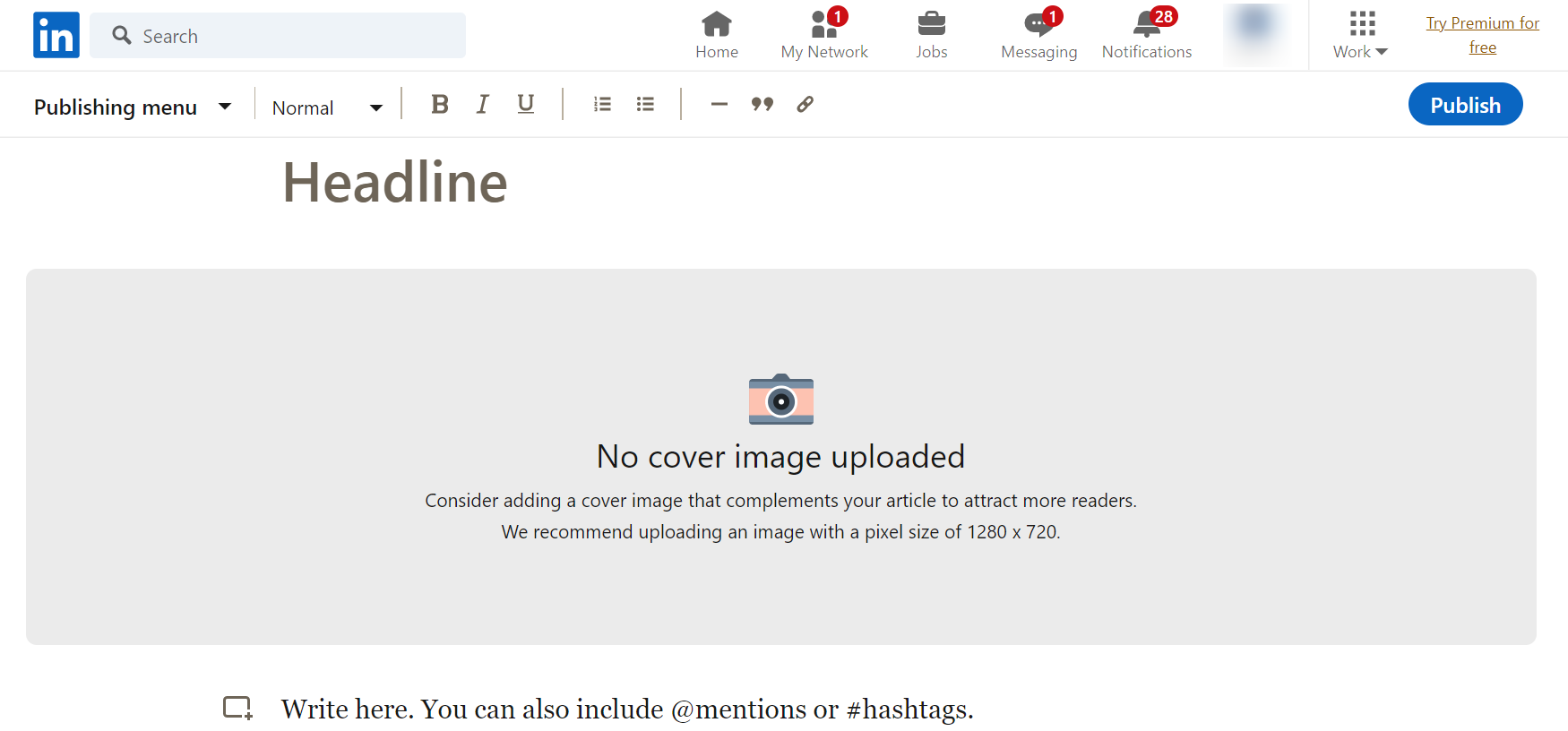Blogging is one of the most powerful ways to promote your business and show people what you know. When you consistently share valuable insights, you create real connections with your audience, earn their trust, and naturally turn readers into loyal customers. A traditional blog on your website can reach readers all over the world, especially with the help of search engines. But imagine being able to blog directly on LinkedIn, speaking to a professional audience that’s already interested in business, growth, and industry expertise.
In this article, we’ll explore why launching a LinkedIn blog can be a game-changer for your brand. We’ll look at how it works alongside a WordPress site, how both platforms can complement each other, and why using LinkedIn’s built-in network can dramatically increase your visibility. After that, we’ll break down practical tips that will help your LinkedIn posts stand out, draw in readers, and keep them engaged.
Let’s dive in and discover how you can use LinkedIn blogging to expand your reach and strengthen your online presence.
Blogging on LinkedIn

When you start publishing on LinkedIn, it’s important to approach your content a bit differently than you would on other platforms. LinkedIn has its own culture and expectations, and keeping those in mind will help your posts perform far better. Generally, there are three key points you should consider before you begin writing.
First, your tone needs to be more polished and professional compared to the casual style used on platforms like Facebook or Instagram. LinkedIn readers expect clarity, insight, and relevance. Using too much slang or overly relaxed language can come across as unprofessional, so aim for a friendly yet refined voice that reflects your expertise.
Second, choose topics that appeal to a business-focused audience. LinkedIn users are typically searching for industry knowledge, professional guidance, or insights that help them make better decisions at work. Content that leans too heavily toward consumer-oriented themes tends to get overlooked. Sticking to B2B subjects gives your posts a better chance of being discovered and shared by people seeking actionable, career-related information.
Finally, remember that SEO still matters, even on LinkedIn. Optimizing your posts with clear keywords, structured headings, and relevant topics helps them perform better on both LinkedIn and Google. This increases the likelihood that your articles will appear in search results rather than get lost among unrelated content. By being intentional with your SEO approach, you give your posts a stronger foundation for long-term visibility.
By keeping these points in mind, your LinkedIn blog can become a meaningful part of your content strategy, helping you reach the right audience with the right message.
Why should you blog on LinkedIn?

Very few social platforms are as purpose-driven and career-focused as LinkedIn. While millions of professionals use it daily, what makes the platform especially valuable is its access to more than 30 million companies. This concentration of businesses makes LinkedIn one of the strongest and most reliable spaces for B2B marketing, networking, and industry visibility.
Publishing articles on LinkedIn can also play a major role in bringing more readers to your main blog or website. Current data shows that the platform has over 500 million members, with roughly half logging in each month. That scale gives you a sense of just how much reach you can gain when you consistently share meaningful, insightful content. With such a large audience already engaged in professional conversations, your posts can reach people actively seeking industry knowledge and expertise.
Another advantage is that LinkedIn publishing is completely free. You do not need to purchase hosting, maintain a domain, or invest in paid ads just to get your thoughts in front of an audience. All you need is a LinkedIn account and a willingness to share valuable content. As you post more often and interact with others, your network grows, your visibility increases, and your articles naturally begin to attract more readers without any financial investment.
Overall, LinkedIn offers a cost-effective, highly targeted platform for sharing your expertise and expanding your professional reach.
Top 5 things to keep in mind when you use LinkedIn as a blogging platform

LinkedIn has become one of the most effective platforms for publishing long-form content, especially for professionals and businesses looking to grow their visibility. When used thoughtfully, the platform can significantly boost your reach, strengthen your brand presence, drive readers back to your main website or blog, and help you build meaningful relationships with people in your industry. Those connections often lead to collaborations, client opportunities, and long-term business growth, which makes LinkedIn an invaluable space for anyone looking to share expertise.
If you’re planning to use LinkedIn as a blogging platform, it’s helpful to approach it with a clear strategy. To make the most of your efforts and ensure your content reaches the right audience, here are five key points to keep in mind.
1) Follow essential blog formatting practices
Even though blogging allows room for creativity, certain structure and formatting guidelines can help your LinkedIn posts perform much better. Paying attention to these basics ensures your content is easy to read, well-organized, and optimized for the platform.
Start with a concise title, ideally 50 characters or fewer. A short, clear title helps readers instantly understand what your post is about and improves its visibility in search results. Beneath that, include a slightly longer headline, around 150 characters, that provides a bit more context and encourages readers to continue.
For the main body of the post, keeping it to about 500 words or fewer is generally effective on LinkedIn. Shorter articles tend to hold attention, especially for professionals scrolling during busy workdays. You can still add value by including relevant links, examples, or images to support your points and enhance the reading experience.
Make sure to include well-chosen keywords throughout the title, headline, and body. This simple step helps your post show up when users search for industry-specific topics on LinkedIn, giving your content a better chance of reaching the right audience.
It’s also important to end with a clear call to action. Whether you want readers to visit your website, download a resource, or contact you for more information, a direct CTA guides them toward the next step.
If you already have experience writing blog posts, many of these principles may feel familiar. But if you’re new to publishing on LinkedIn, keeping these practices in mind will make a noticeable difference in how your posts look, feel, and perform on the platform.
2) Prioritize B2B-focused content for stronger results
If you want your LinkedIn blog to generate meaningful leads, you need a clear content strategy that speaks directly to professionals and organizations. Over time, you’ve likely developed a sense of what your industry cares about, but LinkedIn requires an even more intentional B2B approach. Rather than writing for general readers, shape your content around the needs and interests of companies, team leaders, and decision-makers.
This means considering what topics will actually help businesses solve problems, make informed decisions, or stay ahead of trends. Focusing on industry updates, emerging opportunities, and relevant challenges can significantly boost engagement because you’re addressing issues that matter to professionals in real time.
If you’re unsure where to begin, start by observing the conversations happening on LinkedIn. Follow relevant hashtags and browse posts from others in your field. This will help you identify which topics consistently gain traction and which types of content resonate with your target audience. Over time, these insights will guide you toward subjects that offer the most value and visibility.
3) Build an audience by sharing more than just your own posts
Every time you publish a new article, LinkedIn automatically adds it to your feed. While this helps increase visibility, relying only on your own posts won’t be enough to grow a strong following. Sharing insightful content created by others is equally important.
When you curate high-quality articles, reports, or insights from across your industry, people begin to see you as a reliable source of useful information. The more consistently you share content that helps your audience learn something new, the more trust you build. As professionals recognize your presence in their feed, they become more likely to follow you, interact with your posts, and reach out for potential collaborations or services.
In other words, thoughtful content curation strengthens your credibility and encourages deeper engagement, both of which are essential if you’re aiming to attract more leads.
4) Make SEO a core part of your LinkedIn content strategy
If search engine optimization isn’t part of your content plan, you’re missing an important opportunity. SEO helps your posts remain discoverable long after you publish them, giving your content a longer lifespan. When you apply SEO principles to your LinkedIn articles, you make it easier for both LinkedIn users and Google searchers to find your insights.
Use targeted keywords throughout the structure of your post title, headline, introduction, main body, and closing section. This not only helps readers identify the subject quickly but also signals to search engines what your content is about. With the right keywords and clear formatting, your LinkedIn articles can appear in search results long after they were posted, giving your work steady, ongoing visibility.
5) Maintain consistency to keep your audience engaged
Consistency is one of the biggest factors in building momentum on LinkedIn. You don’t have to publish lengthy articles every time; even shorter posts can make an impact if you show up regularly. Consistent activity keeps your profile visible and helps your audience view you as a dependable source of insights.
You can also expand your output by repurposing existing content. Old WordPress blog posts, articles from your website, or even older LinkedIn posts can be refreshed and shared again. Many creators also split long blog articles into several short status updates. For example, one strong piece of content can be broken into multiple smaller posts, each highlighting a specific point or idea.
By staying consistent and making the most of the content you already have, you maintain a steady presence on the platform and continue to build relationships with your audience over time.
Do You Really Need LinkedIn Ads to Promote Your Posts?
While LinkedIn does offer paid advertising options, relying on ads within your content isn’t usually the most effective approach. Readers on the platform tend to respond more positively to posts that offer genuine insight rather than promotional material. High-value content, such as thoughtful articles, tutorials, case studies, or industry reflections, creates a far stronger impact than paid placements. This is why blogging and content marketing remain the most effective ways to engage your audience on LinkedIn.
Professionals on the platform are continually seeking information to improve their work, better understand their industry, or stay ahead of new developments. This gives you an excellent opportunity to share your knowledge and position yourself as someone who deeply understands the field. Over time, consistently providing helpful insights can help you grow a reputation as a trusted expert or thought leader.
At its core, LinkedIn is built around professional relationships. When you offer real value, people begin to view you as someone they can learn from and rely on. This not only strengthens your presence on the platform but also opens the door to new connections, collaborations, and business opportunities. As your credibility grows, so does your ability to form meaningful partnerships with others in your industry, including fellow bloggers, ultimately supporting long-term growth for your business.
Also, Read:
- Is LinkedIn Premium worth it?
- How Much Money Does Instagram Influencers Make?
- 10 Best LinkedIn Automation Tools
Conclusion – Is LinkedIn Blogging worth it?
LinkedIn can be an exceptionally powerful platform for reaching other businesses, even if you’re not currently searching for a job or hiring new talent. Its audience comprises professionals, leaders, and decision-makers, making it an ideal space to share well-researched, authoritative content from your field. When you publish thoughtful insights, guides, or perspectives, you not only strengthen your brand’s credibility but also encourage readers to visit your main website or blog to learn more.
Because of these advantages, LinkedIn deserves a high place on your list when you’re evaluating the best platforms for blogging. It offers a built-in audience, strong networking potential, and tools designed specifically for professional communication. If you haven’t explored LinkedIn as part of your content strategy yet, it’s a great time to create an account, refine your profile, and start sharing meaningful posts. Consistent, high-quality content on LinkedIn can significantly enhance your visibility and help you build long-term relationships within your industry.

